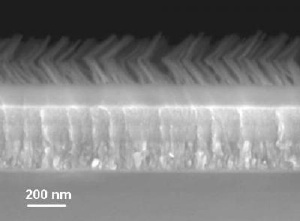Nov 4 2008
No matter which way you look at it, the notion of harvesting energy from the sun to power our homes and businesses is more absorbing than ever.
 A new anti-reflective coating developed by researchers at Rensselaer Polytechnic Institute could help to overcome two major hurdles blocking the progress and wider use of solar power. The nanoengineered coating boosts the amount of sunlight captured by solar panels and allows those panels to absorb the entire spectrum of sunlight from any angle, regardless of the sun's position in the sky. Credit: Rensselaer/Shawn Lin
A new anti-reflective coating developed by researchers at Rensselaer Polytechnic Institute could help to overcome two major hurdles blocking the progress and wider use of solar power. The nanoengineered coating boosts the amount of sunlight captured by solar panels and allows those panels to absorb the entire spectrum of sunlight from any angle, regardless of the sun's position in the sky. Credit: Rensselaer/Shawn Lin
Researchers at Rensselaer Polytechnic Institute have discovered and demonstrated a new method for overcoming two major hurdles facing solar energy. By developing a new antireflective coating that boosts the amount of sunlight captured by solar panels and allows those panels to absorb the entire solar spectrum from nearly any angle, the research team has moved academia and industry closer to realizing high-efficiency, cost-effective solar power.
"To get maximum efficiency when converting solar power into electricity, you want a solar panel that can absorb nearly every single photon of light, regardless of the sun's position in the sky," said Shawn-Yu Lin, professor of physics at Rensselaer and a member of the university's Future Chips Constellation, who led the research project. "Our new antireflective coating makes this possible."
Results of the year-long project are explained in the paper "Realization of a Near Perfect Antireflection Coating for Silicon Solar Energy," published this week by the journal Optics Letters.
An untreated silicon solar cell only absorbs 67.4 percent of sunlight shone upon it — meaning that nearly one-third of that sunlight is reflected away and thus unharvestable. From an economic and efficiency perspective, this unharvested light is wasted potential and a major barrier hampering the proliferation and widespread adoption of solar power.
After a silicon surface was treated with Lin's new nanoengineered reflective coating, however, the material absorbed 96.21 percent of sunlight shone upon it — meaning that only 3.79 percent of the sunlight was reflected and unharvested. This huge gain in absorption was consistent across the entire spectrum of sunlight, from UV to visible light and infrared, and moves solar power a significant step forward toward economic viability.
Lin's new coating also successfully tackles the tricky challenge of angles.
Most surfaces and coatings are designed to absorb light — i.e., be antireflective — and transmit light — i.e., allow the light to pass through it — from a specific range of angles. Eyeglass lenses, for example, will absorb and transmit quite a bit of light from a light source directly in front of them, but those same lenses would absorb and transmit considerably less light if the light source were off to the side or on the wearer's periphery.
This same is true of conventional solar panels, which is why some industrial solar arrays are mechanized to slowly move throughout the day so their panels are perfectly aligned with the sun's position in the sky. Without this automated movement, the panels would not be optimally positioned and would therefore absorb less sunlight. The tradeoff for this increased efficiency, however, is the energy needed to power the automation system, the cost of upkeeping this system, and the possibility of errors or misalignment.
Lin's discovery could antiquate these automated solar arrays, as his antireflective coating absorbs sunlight evenly and equally from all angles. This means that a stationary solar panel treated with the coating would absorb 96.21 percent of sunlight no matter the position of the sun in the sky. So along with significantly better absorption of sunlight, Lin's discovery could also enable a new generation of stationary, more cost-efficient solar arrays.
"At the beginning of the project, we asked 'would it be possible to create a single antireflective structure that can work from all angles?' Then we attacked the problem from a fundamental perspective, tested and fine-tuned our theory, and created a working device," Lin said. Rensselaer physics graduate student Mei-Ling Kuo played a key role in the investigations.
Typical antireflective coatings are engineered to transmit light of one particular wavelength. Lin's new coating stacks seven of these layers, one on top of the other, in such a way that each layer enhances the antireflective properties of the layer below it. These additional layers also help to "bend" the flow of sunlight to an angle that augments the coating's antireflective properties. This means that each layer not only transmits sunlight, it also helps to capture any light that may have otherwise been reflected off of the layers below it.
The seven layers, each with a height of 50 nanometers to 100 nanometers, are made up of silicon dioxide and titanium dioxide nanorods positioned at an oblique angle — each layer looks and functions similar to a dense forest where sunlight is "captured" between the trees. The nanorods were attached to a silicon substrate via chemical vapor disposition, and Lin said the new coating can be affixed to nearly any photovoltaic materials for use in solar cells, including III-V multi-junction and cadmium telluride.
Along with Lin and Kuo, co-authors of the paper include E. Fred Schubert, Wellfleet Senior Constellation Professor of Future Chips at Rensselaer; Research Assistant Professor Jong Kyu Kim; Research Associate Yong Sung Kim; physics graduate student David Poxson; and electrical engineering graduate student Frank Mont.